Family : Fringillidae

Text © Dr. Gianfranco Colombo

English translation by Mario Beltramini
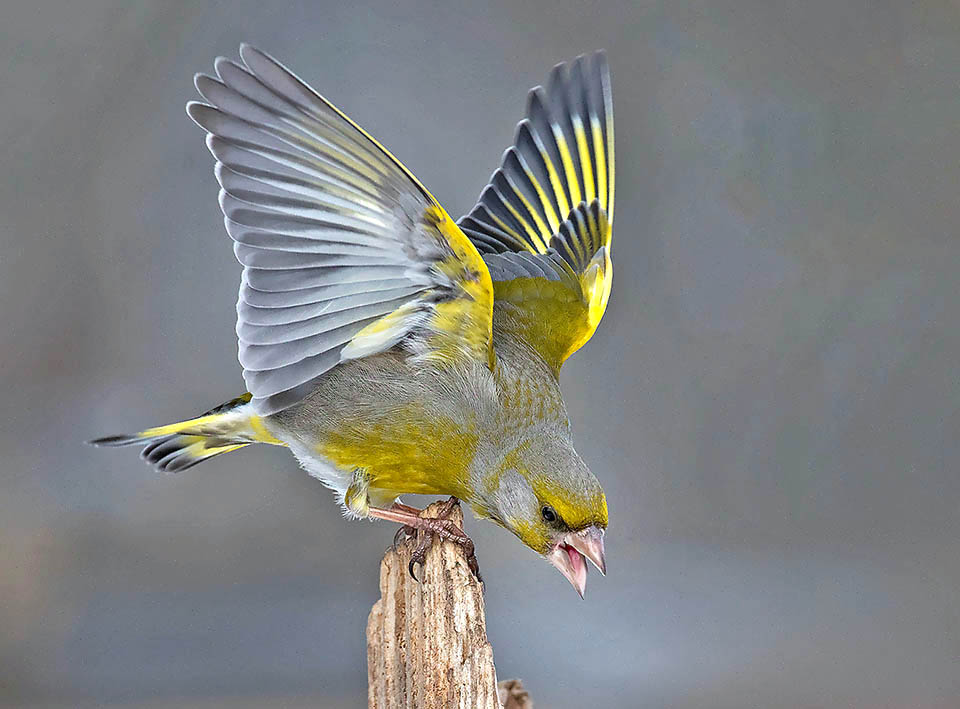
Finch and Canary close relative, with which is at times hybridized, the Greenfinch (Chloris chloris) is stronger, with a big and fearsome beak © Геннадий
The Greenfinch or European greenfinch, Chloris chloris (Linnaeus, 1758), is a graceful and common little bird that belongs to the order of the Passeriformes and to the family of the Fringillidae and as both the scientific and common names state has a characteristic greenish livery.
Always placed in the genus Carduelis, only recently has been inserted in Chloris adopting a tautonymous binomial seeing the repetition of the same name in the genus as well as in the species: Chloris from the ancient Greek “khloros”, green, to confirm the colour of its livery.
The etymology of Carduelis comes from the Latin “carduus”, cardoon, thistle, the most loved food by this genus of birds.
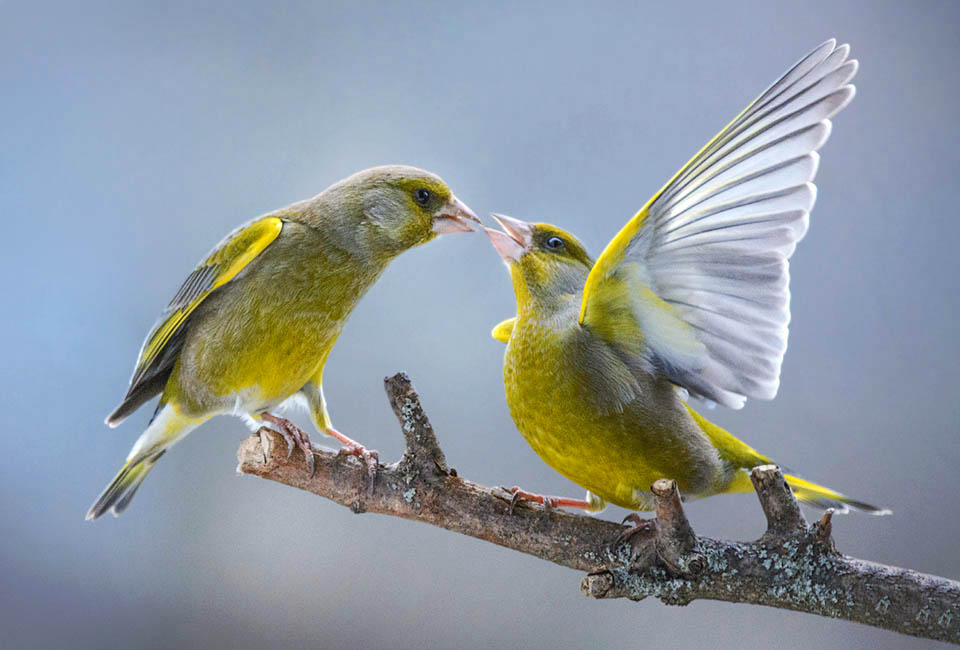
Here dispute between males, but may overwhelm even bigger and combative birds such as a Blackbird, a Robin or a Great tit © Светлана Медведева
However, this new allocation is not entirely shared and many taxonomists keep tied to the old classification, while waiting for the situation to be finally clarified and totally shared by the ornithological world.
Moreover, we have also to consider that Linnaeus himself originally placed this small bird in the genus Loxia, the same of the Crossbills, perhaps based on the robustness and on the quite stocky dimensions of this finch, indeed very similar as characteristics to those of the crossbills.
As a matter of fact, as we shall see in the morphological part of this sheet, the Greenfinch displays a compact and strong look that allows him to tower over birds of its size and at times even much bigger and most fearsome birds.
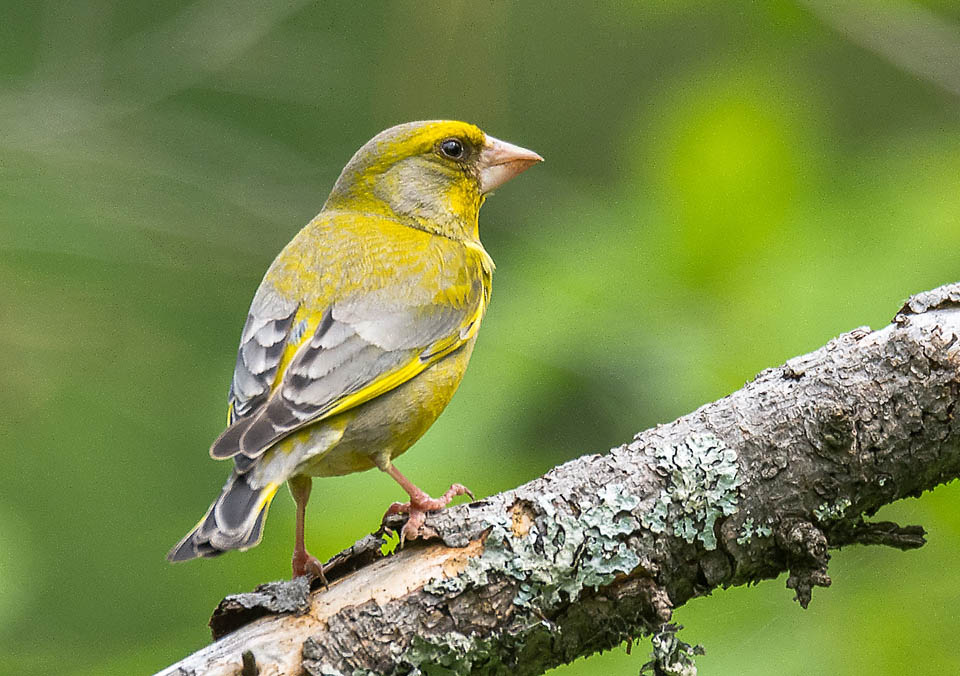
Chloris chloris shows a remarkable sexual dimorphism. In the males, the olive green of the livery, that originated the common name, in fact often tends yellow © Александр
Just observe it in its winter feeders, when mixed with many other hungry species, asserts its supremacy by moving away from the perches whoever tries to get closer.
It spreads its wings slightly, gnashes threateningly its large beak, lowers on the body as if to take a run-up and pecks at the intruder, regardless if it is a blackbird, a robin or a blue tit, birds notoriously not easy to deal with.
Even among them, greenfinches, although quite social birds, coexistence is not easy, not only on the mangroves but even more while courting and defending their territory.
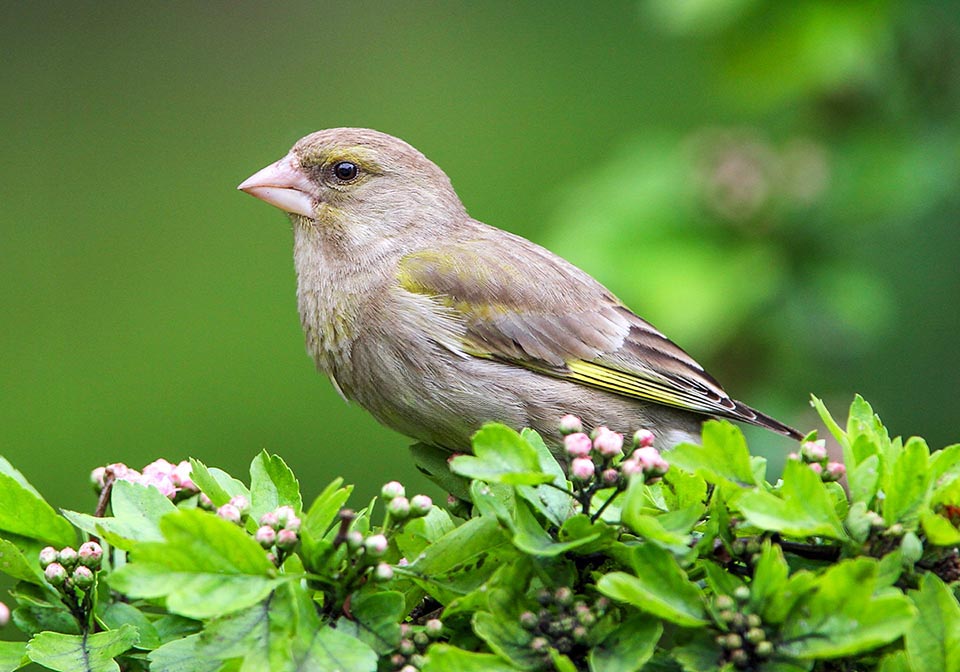
The females, who must not seduce but get unobserved while hatching conversely have dull colours and tend greyish © Christoph Moning
In this regard, Chloris chloris is perhaps the master of the bat flight, a characteristic shared with few other finches that is done in the delimitation of the nesting territory.
This is the first clue of its presence and of the taking possession of a nesting area. A circular flight as large as the area occupied, with a slow-motion flap of wings and with very wide open wings so much to appear like a real bat, accompanied invariably by its usual nasal singing.
It is an operation the male repeats incessantly for many days even after having conquered the female and that serves as deterrent to other rivals.
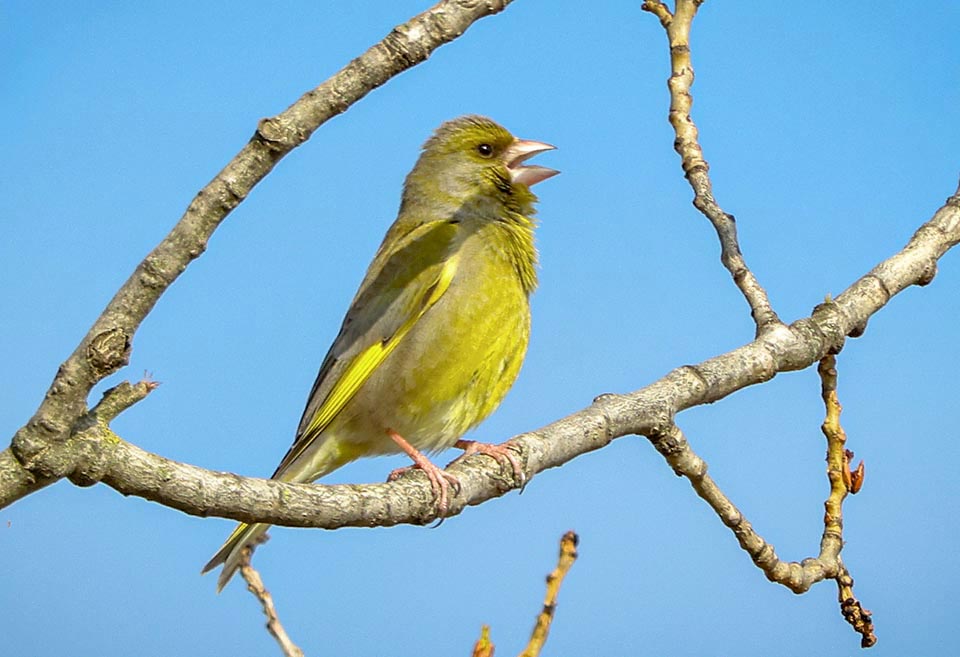
Greenfinch song is snot melodious like that of most finches but its shrill trills serve however for delimiting the territory © Susanne Spindler
Being a well spread bird throughout Europe, has earned an infinite number of nicknames, almost always with explicit reference to its typical colour.
In Italy we find Searnto, Sciaranto, Cerant, Cirant, Verduna, Vidduni, Verder, or, in the Anglo-Saxon world, Green linnet, Green grosbeak and also, friendly, Greenies.
Other common European names are: Verdier d’Europe in French, Verderón Común in Spanish, Grünfink in German, Verdilhão-comum in Portuguese, European Greenfinch in English and a nice Aokawarahiwa in Japanese.
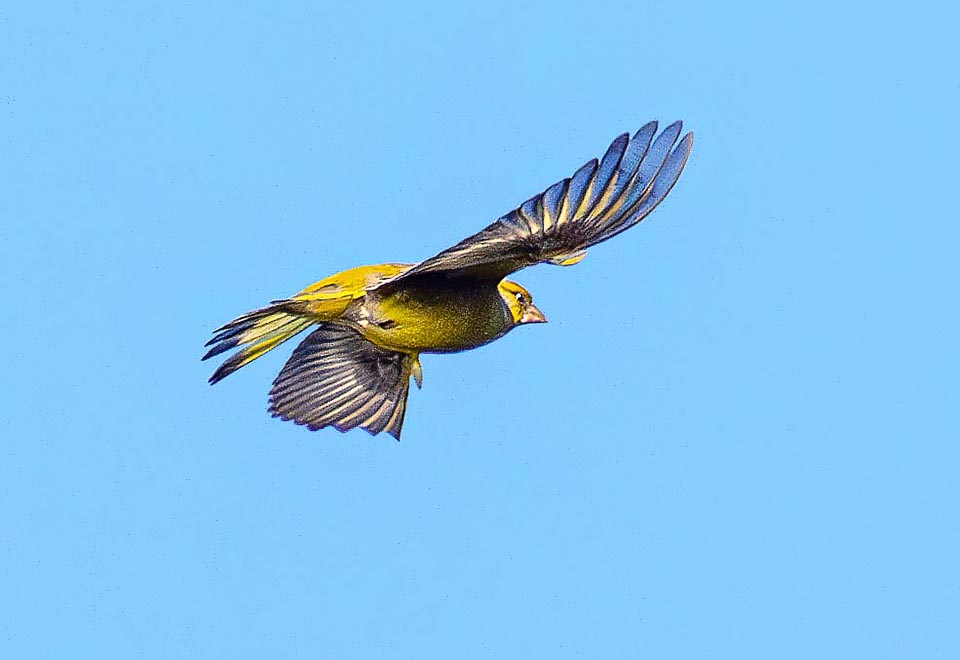
Moreover the nesting area is delimited by typical male’s perimetral flights, bat-like, with quite spread wings keep beating in slow motion © Matt Blango
Zoogeography
Chloris chloris is a typical European finch, with largely resident populations, well diffused throughout all the territory and rather numerous. It is absent only from Iceland and in the extreme northern part of the Scandinavian peninsula and of European Russia whilst is present also in the Middle East, in Caucasus and on the north western African coasts and inexplicably with an isolated population in Kyrgyzstan and surrounding areas.
It has been introduced into South Australia and in New Zealand where it has now well established populations and in some regions of South America, such as Uruguay and Argentina. The Greenfinch, not being a good flyer, is usually sedentary, except for some populations located in the northernmost range that keep moving during the bad season in more southern areas, but always inside the traditional area.
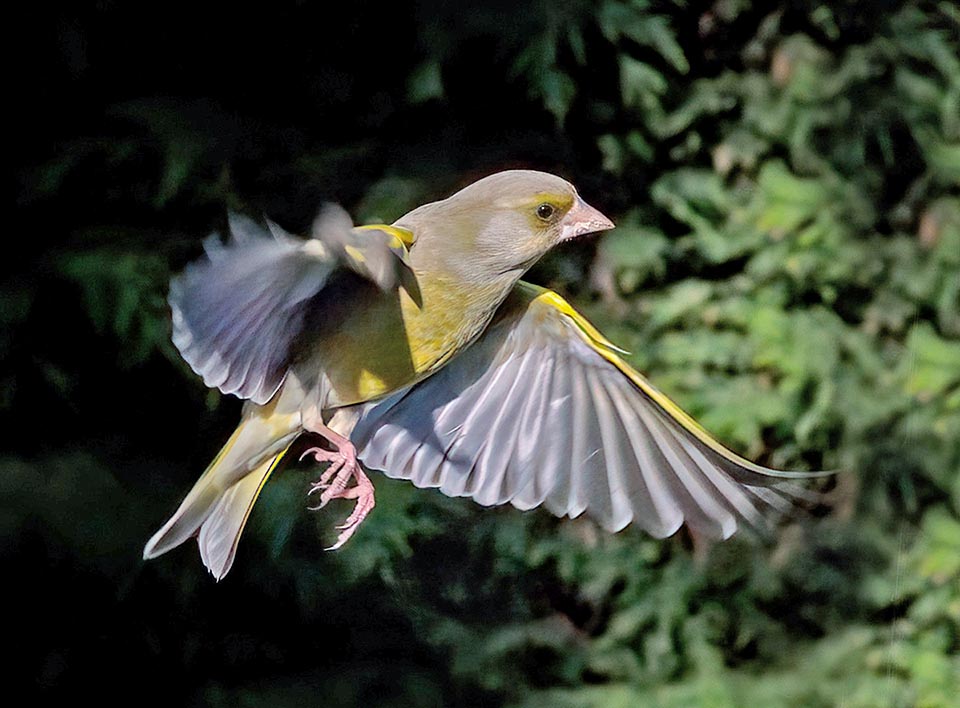
While hatching, done for two weeks by the female, the male surveys the area and provides for the sustenance of the partner © torbjornhultmark
It’s in this period that it gets strongly social, forming very numerous flocks, often mixed with other finches, with whom it spends the winter grazing in the uncultivated lands looking for food.
Even though always tied to a well delimited territory, this species have originated about ten subspecies, not recognized by all, typical of peripheral areas or of isolated populations. Carduelis chloris harrisoni of the British islands, Carduelis chloris muehlei of the Balkan peninsula, Carduelis chloris aurantiiventris of the Mediterranean area and of Macaronesia, Carduelis chloris voosi of north-western Africa, Carduelis chloris vanmarli of Morocco, Carduelis chloris chlorotica of the Middle East, Carduelis chloris bilkevitchi of Caucasus, Carduelis chloris bilkevitchi of Kyrgyzstan, Carduelis chloris chloris of continental Europe and a particular subspecies, Carduelis chloris madaraszi typical of Corsica and of Sardinia.
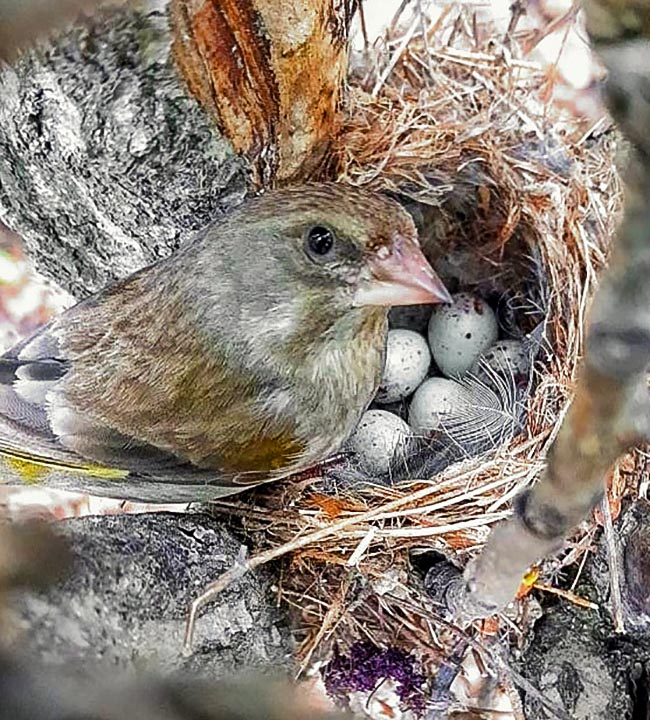
She’s the one choosing the nest place and the male helps her building with mosses, grasses, animal bristles and hair © Вероника Карандасова
Ecology-Habitat
Chloris chloris loves the not too densely wooded zones, interspersed with large grassy and bushy spaces but does not fail to occupy heavily cultivated areas, woods and orchards and also gardens and parks of inhabited centres provided with trees and bush shrubs.
Being a strictly granivorous bird, it has benefited from, in some cases, the agricultural reconversions that have seen the prevalence of cereal cultivations at the expense of uncultivated grasslands, its ancestral habitat, reconverting itself again in favour of innovation.
This demonstrates the ease of adaptation of this bird.
In any case the preferred habitat always remains the stable meadow with all its traditional essences, the uncultivated grasslands with low bushes full of berries, banks of ditches and of troughs with perennial water and small wooded areas where, if needed, to install the nest.
Morphophysiology
There is a significant sexual dimorphism in this species, mainly due to the more marked presence of the yellow colour in the livery of the male, that in the female is less marked and absolutely missing in the juveniles.
Even though it does not have a very varied livery, the Greenfinch does display a natural elegance in its plumage.
The olive green colour is prominent in both liveries, a colour that covers totally the body of these birds with light and dark shades that affect various parts of the body.
In the male the green colour tends more to yellowish all over the body and the lemon yellow is well evident on the primary remiges, on the shoulders and on the tail whilst in the female the whole is more mitigated and greyish.
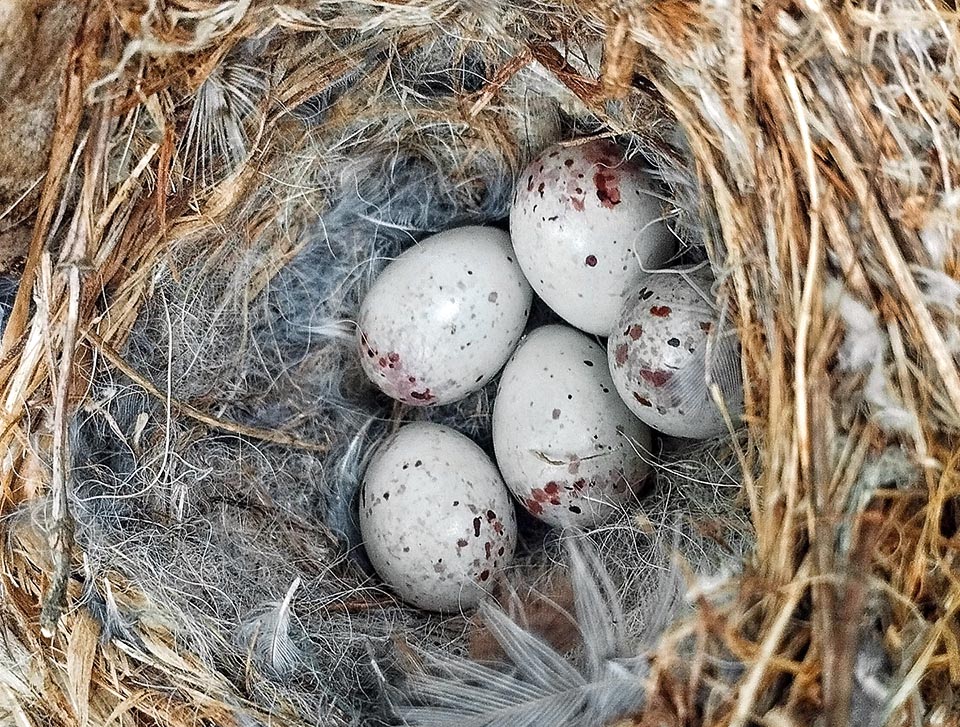
Contains in average 5 about 25 mm long eggs, of cream white colour irregularly speckled reddish on the side opposite to the tip © Вероника Карандасова
The female and the immature young, are quite similar in winter and often, also for relevance in attitudes and robustness, they can be mistaken with our house sparrows or with a female of bunting.
Chloris chloris is a robust little bird, with big head and a bill conical, very strong and equipped with a remarkable strength that allows it to break even the hardest and resistant seeds.
Like most finches, the tail has external rectrices slightly longer granting it a rather biforked shape and well visible also from far away.
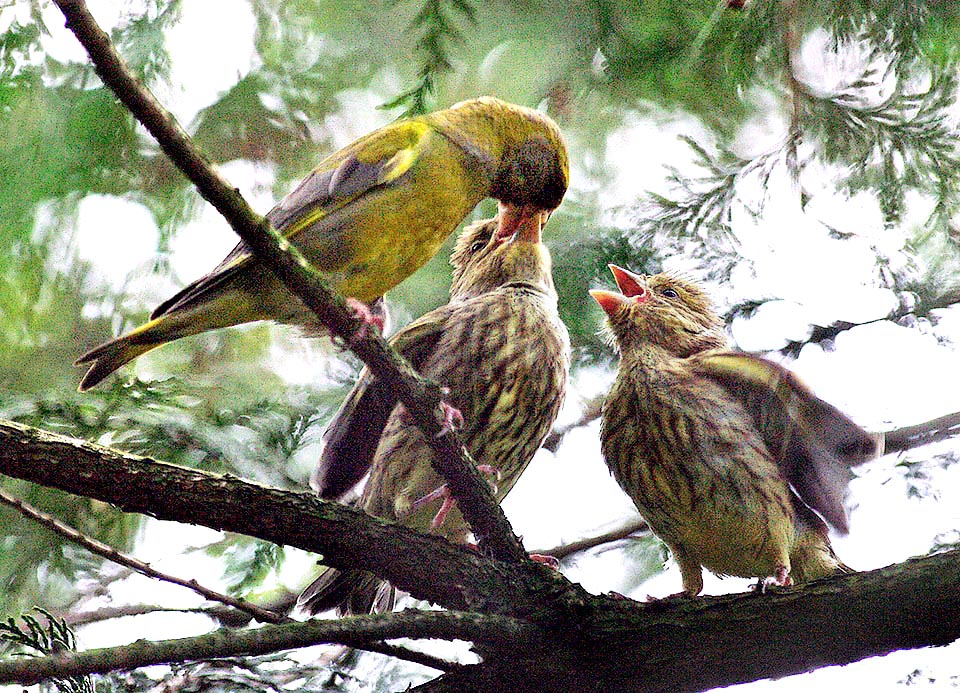
Chicks are fed with regurgitated food by both parents. In their early days of life with insects, for a protein input, and then with vegetables © textman
The beak is pearly and the legs are of flesh-grey colour. The iris is brown, dark in colour.
The total length is of 15-16 cm, an average weight of 26 g and a wingspan of 28 cm: the Greenfinch is the largest species in its genus.
Ethology and Reproductive Biology
Already since the month of March, the Greenfinch begins the courting and the delimitation of the territory, an area it will keep for all the summer months to grow the two and at times the three broods that normally does every year.
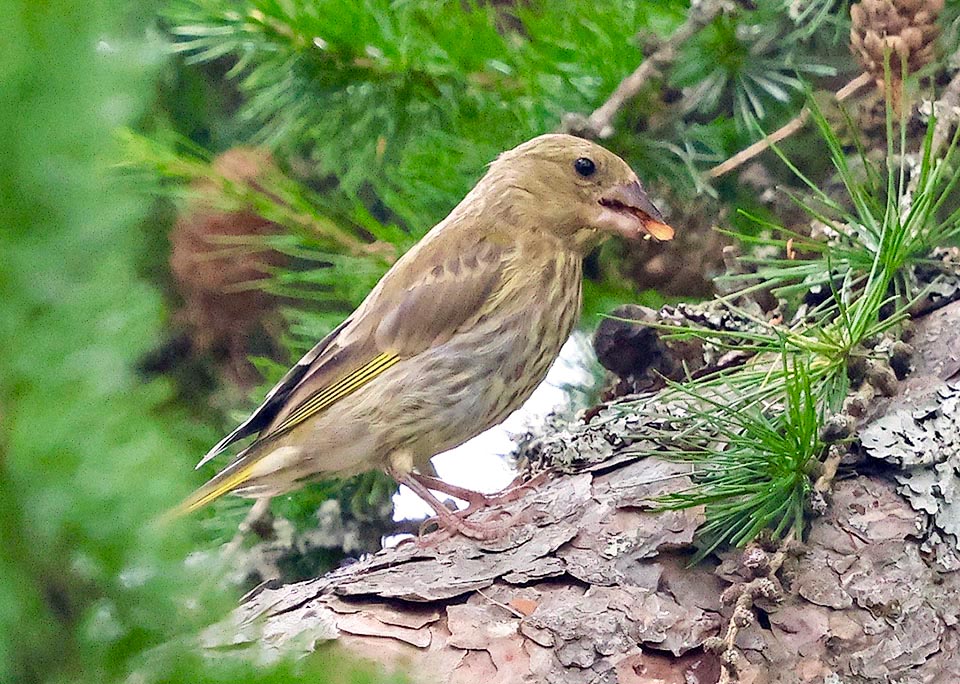
Here a juvenile dealing with a seed. To note the typical speckling on the chest and the absence of colours © Antti Henttonen
Once chosen the partner the female begins independently the construction of the nest that is usually placed in a tall leafy bush or leaning against the trunk of a tree at the fork of a branch, often hidden in a climber and well camouflaged.
The nest is a large, rather messy, platform formed by twigs and small pieces of bark, with a perfect cup at the centre, made with very fine and soft plant material, intertwined rootlets and very thin blades of grass and unfailingly animal hair and bristles.
The inside is made soft by vegetable fluff and soft down and the cup has a depth of some centimetres, enough to create a comfortable and warm niche during the hatching period.
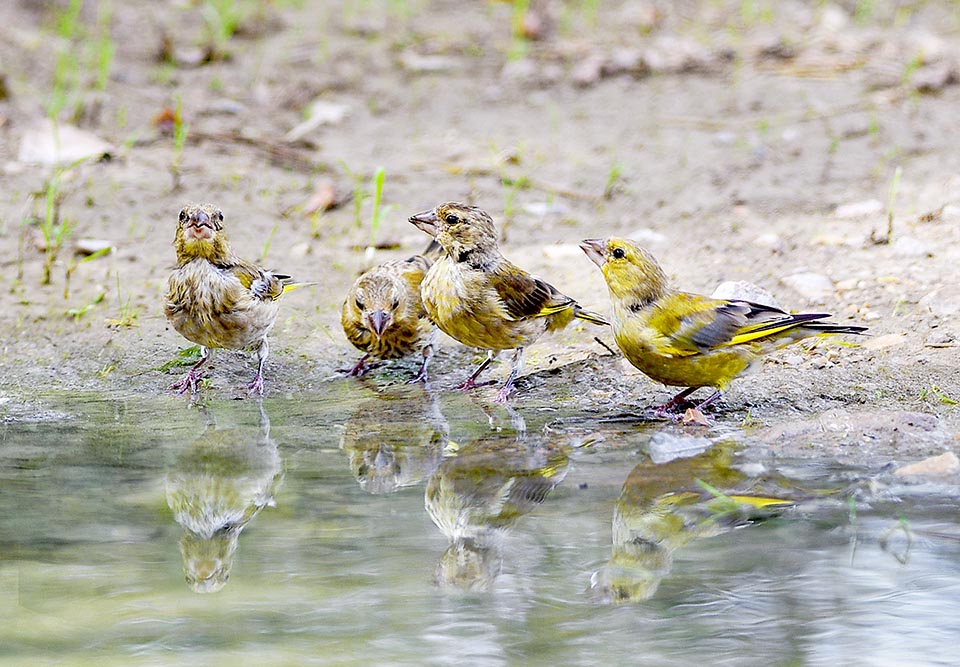
For short time after fledging the kids follow the parents in their raids, learning the resting and feeding places © Gianfranco Colombo
On average, are laid five eggs of cream white colour diffusely speckled with reddish that are hatched only by the female for about two weeks whilst the male will be busy in the defense of the territory. During this period often the male brings food also to the female thus making the brooding uninterrupted.
The nestlings are followed by both parents for two weeks and even for some days after fledging but rapidly the young get independent and lose all contact with their parents, gathering usually in young groups.
Chloris chloris is a purely granivorous bird so much that while nesting, only occasionally carries insects to the nest for feeding its chicks, contrary to what all the birds do feeding on vegetable food, preferring instead to regurgitate pre-digested seeds.
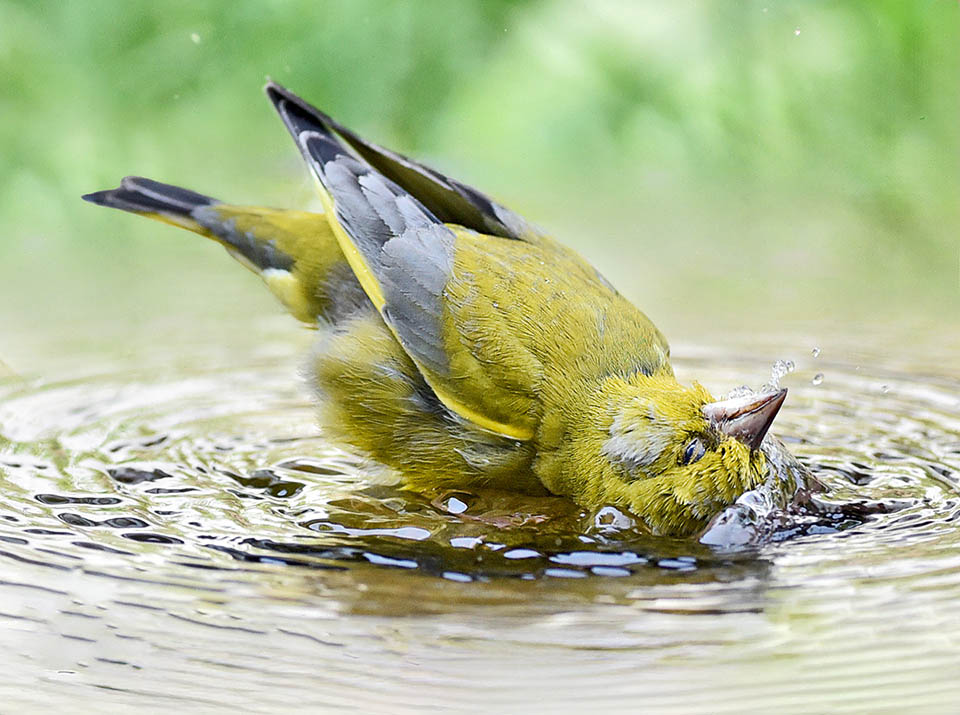
During the summer heat they don’t miss restorative baths for maintaining a perfect livery © Gianfranco Colombo
The seeds preferred are those of sunflower and other oily grains even if remarkably hard that are easily broken by their beak that expresses a considerable strength. Of course, also the thistle stands among its preferences, just not to forget its belonging to the genus Carduelis.
The song of the Greenfinch is not melodious like that of most finches but is however always pleasant if it is interspersed by shrill and uncoordinated trills and by dull buzzes.
However, in the Victorian period this bird was heavily hunted alongwith Goldfinches and Linnets, for caging it and for enjoying its song.
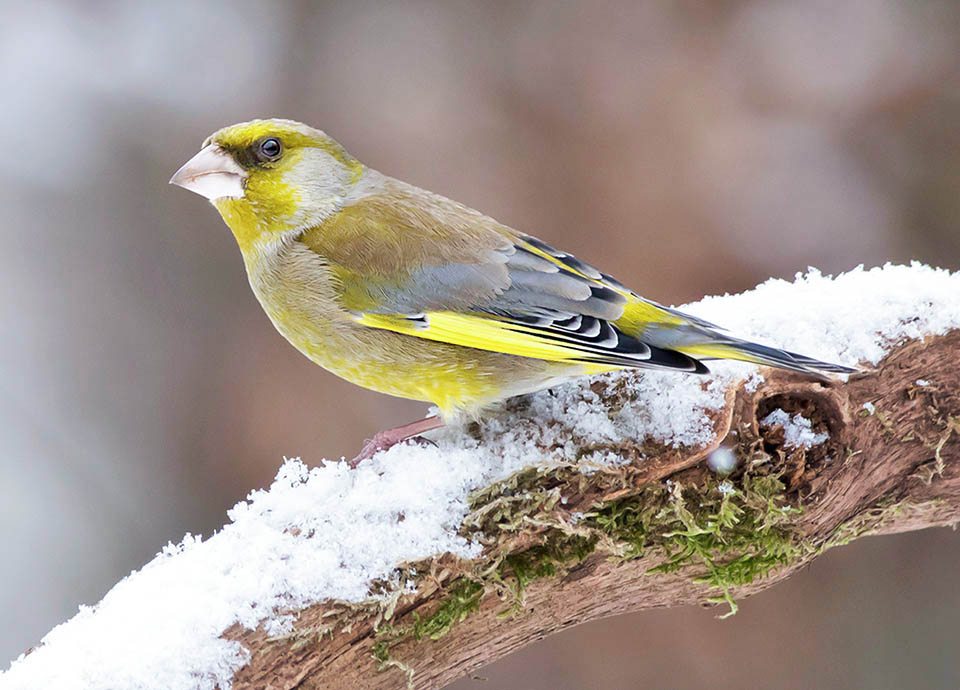
The Greenfinch is not a strong migrant and if it finds a suitable place for its needs can calmly endure a snowfall © Gianfranco Colombo
The Greenfinch, though small, is a fairly strong and resistant bird to environmental conditions as well as to the problems that involve birds of this size, however, often, the most insidious foe does not come from the sky or the soil, but stands inside the nests in the form of parasites.
Not many years ago the populations of Greenfinches of the United Kingdom have suffered a decimation because of the Avian trichomoniasis that has decimated the populations in a disproportionate way. It is in fact still today one of the most affected birds by this parasite. In any case the populations are stable and from 2018 Chloris chloris appears as “LC, Least Concern” in the IUCN List of the endangered species.
Synonyms
Loxia chloris Linnaeus, 1758; Carduelis chloris Linnaeus, 1758.
→ To appreciate the biodiversity within PASSERIFORMES please click here.
